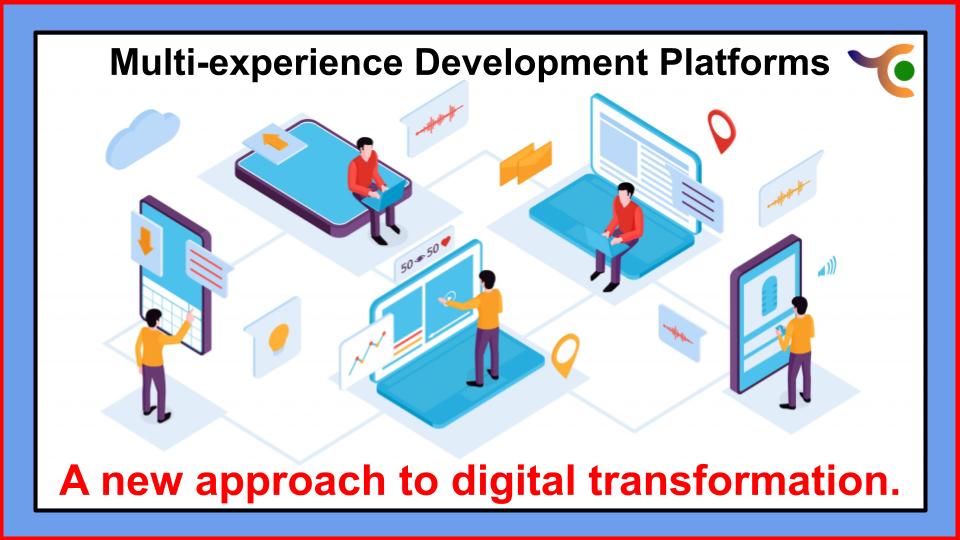Multi-experience refers to a user’s overall experience, using a variety of digital touchpoints – websites, mobile apps, chatbots, augmented reality/virtual reality, and wearables using a combination of interaction modalities such as touch, voice, vision, and motion we do. The objective multi-experience development platforms is to support a seamless and consistent user journey.
It is no longer a question for companies whether to deploy just a web platform or mobile or both. It’s about working with a growing market of devices and the respective experience of each. The application must run flawlessly on the platform while creating a consistent and engaging connection.
Multi-experience development involves creating fit-for-purpose touchpoints based on specific modalities while maintaining a consistent customer experience across mediums such as websites, mobile, and desktop apps, smartwatches, and more.
Importance
As new digital touchpoints become more widely available, customers are increasingly demanding experiences across new digital touchpoints. This leads enterprises to invest in platforms that enable them to easily develop for these digital touchpoints.
The increasing growth of mobile apps prompted enterprises to seek development platforms to facilitate mobile app creation. This led to the rise of the Mobile Application Development Platform (MADP). With the increasing importance of new devices such as wearables or new interfaces such as natural language, the Multi-experience development program(MXDP) is in equal demand.
As the number of apps, devices, and modes of interaction proliferates, so will the need for a multi-experience development platform. As customers have access to devices with new ways to interact, the demand for such services increases. And the use of wearable, conversational and immersive devices and apps is definitely on the rise, according to various sources:
- Connected wearable devices worldwide: 526 million
- Estimated number of VR and AR devices to be sold in 2021: 52 million
Multi-experience expansion is one of the business drivers in digital transformation. Businesses invest in multi-experience platforms to cost-effectively build multi-channel apps to continue their digital transformation journey.
Technologies used in Multi-experience Development Platforms
Visual and touch interfaces are already well-established and essential for most B2C applications. Given below are new platforms and developers need to consider whether they should take advantage of them in their new applications as not all of these technologies are relevant to all applications.
- Chatbots (Conversational UI): Software that enables people to receive information from machines in a natural, conversational manner using text and voice. For example, automotive companies use chatbots, such as Kia’s Kian, that can answer customer questions and increase conversion rates.
- Augmented Reality: AR devices augment the visualization of real-world environments with computer-generated data. For example, Qwake Technologies has created a smoke-diving helmet for firefighters so firefighters can get in and out of dangerous situations faster with clear vision.
- Virtual Reality: VR is a simulated perceptible environment that is created by computer technology. In this reality, a person can interconnect with objects and enact a sequence of actions. For example, the PlayStation VR is a virtual reality headset that allows users to play an interactive role in a game environment.
- Wearable: Wearables are smart electronic devices that are made to be worn on the user’s body where they can interact with smartphone apps. Bluetooth headset and smartwatch included.
Examples
Domino’s Anywhere is one of the most well-known brands that use multi-experience development platforms to enable its customers to interact with their brand from any device or app. Pizza ordering devices and apps include:
- Google Home
- Alexa
- Loose
- Messenger
- Zero click
- Basic lesson
- Tweet
- Car
- Smart TV
- Voice Assistant
- Smartwatch
Benefits And Risks
Benefits
- Multi-experience development platforms can increase collaboration between IT and business teams in the process of building, designing, and managing apps and customer experiences.
- Companies can rapidly develop applications for new digital touchpoints and platforms
- As developers’ productivity increases across multiple touchpoints due to high-productivity tooling and common development languages, businesses shorten app delivery times.
- Core back-end services are portable and reusable, reducing the cost of developing an app across any touchpoint.
Risks
- Due to the reliance on the platform to support multiple touchpoints, there is a risk of vendor lock-in.
- Technical teams may need to modify existing development tooling and DevOps practices to take full advantage of MXDP and develop multi-experience applications with limited investment.
About Us:
TriColor Initiative (TCI) is the organization where you get solutions to every problem related to API integration. Our team specializes in the process of building, designing, and managing apps and helping you to grow your business better.


